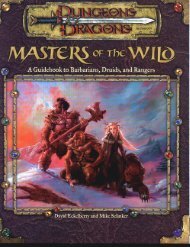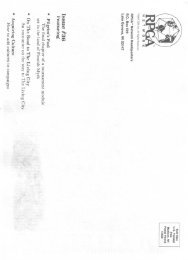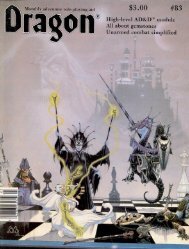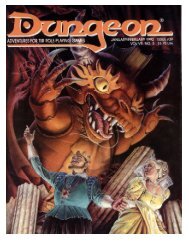Accessory - Dragon Magazine #111.pdf - Index of
Accessory - Dragon Magazine #111.pdf - Index of
Accessory - Dragon Magazine #111.pdf - Index of
Create successful ePaper yourself
Turn your PDF publications into a flip-book with our unique Google optimized e-Paper software.
Microscopic monsters<br />
When they get bigger, they get a lot tougher<br />
by Kent Colbath<br />
After several years <strong>of</strong> serving as a Dungeon Master, you may<br />
notice a certain sameness creeping into the routine parts <strong>of</strong> your<br />
adventures. As the characters advance toward whatever new twisted<br />
beast you’ve created to guard the latest fabulous treasure, they<br />
generally blunder through the standard assortment <strong>of</strong> orcs, giant<br />
rats, and zombies. Granted that for higher-level characters these<br />
may be replaced by ogres, wolves, and ghouls (or even telephone<br />
sanitizers, middle-level managers, and IRS agents if the DM is<br />
really sadistic), the effect is much the same. Where is a DM to turn<br />
for information on new lower-level creatures to inhabit his fantasy<br />
landscape?<br />
One productive source <strong>of</strong> new monsters may be literally found<br />
underfoot. Single-celled plants and animals have a variety <strong>of</strong> bizarre<br />
properties which are ideally suited to the AD&D® game. Many <strong>of</strong><br />
these creatures also have the virtue <strong>of</strong> living in water, a habitat<br />
which is particularly neglected in the available monster collections.<br />
There are two ways to bring these monsters into play. The first is<br />
to shrink the characters to a very small size by magical means. Note<br />
that the characters must shrink to a fraction <strong>of</strong> an inch before a<br />
single-celled creature becomes much <strong>of</strong> a threat. This requires a<br />
shrinking spell <strong>of</strong> exceptional power.<br />
The second, and I think more interesting, way to bring the monsters<br />
into play is by enlarging them (this is assumed in the descriptions<br />
given below). A high-powered enlarge spell cast on murky<br />
pond water would do the trick. More systematic enlargement <strong>of</strong> the<br />
cells might be undertaken by a powerful magic-user, human or<br />
otherwise, who would use the cells for some purpose.<br />
PROTISTON<br />
One creation I’ve developed that may serve to introduce giant<br />
single-celled beasts to a campaign is Protiston, who may or may not<br />
exist at the option <strong>of</strong> the DM. Protiston is giant slime mold, a type<br />
<strong>of</strong> creature (described below) which alternates between being a<br />
swarm <strong>of</strong> individual amoebae and a colony that looks like a large,<br />
distorted mushroom. Each individual amoebal cell carries a certain<br />
amount <strong>of</strong> information, so Protiston functions much like a very slow<br />
computer.<br />
Protiston (as it was named by the mage who discovered it) began<br />
as a simple collection <strong>of</strong> single-celled creatures in a large body <strong>of</strong><br />
water, such as a sea or an ocean. At some some point in the distant<br />
past, Protiston became so large and complex that it acquired intelligence,<br />
and slowly thereafter gained magical skills. Being <strong>of</strong> such an<br />
alien intelligence, Protiston has no understanding at all <strong>of</strong> “normal”<br />
human thought, and regards everything around it as either a food<br />
source or “hostile environment” to be overcome and destroyed. No<br />
one knows for sure, but the chaotic evil alignment detected from<br />
Protiston may stem from either Protiston’s innate disregard for all<br />
other forms <strong>of</strong> life, or from some form <strong>of</strong> association with the demon<br />
prince Juiblex (which might explain how Protiston gained spellcasting<br />
abilities). Little else is known <strong>of</strong> this being’s origins or intent,<br />
save that it wishes to “eat” the entire world or shape it to benefit<br />
itself. Few beings are even aware that this creature exists — and few<br />
who have found it have lived to tell about it later.<br />
As presently constituted, Protiston inhabits the interior <strong>of</strong> a large<br />
coral atoll (or a calm, shoreline cavern, if placed in an inland sea by<br />
the DM). Numerous support colonies <strong>of</strong> amoebae may be found<br />
around it. Although a single thought in Protiston’s “mind” may<br />
take anywhere from a few seconds to a few weeks to complete, Protiston<br />
is highly intelligent and has gained the powers <strong>of</strong> a 12th-level<br />
magic-user, being able to cast spells like push, shield, continual<br />
darkness/light, ray <strong>of</strong> enfeeblement, stinking cloud (above water),<br />
hold person, protection from normal missiles, slow, hallucinatory<br />
terrain, plant growth, cloudkill (above water), hold monster, telekinesis,<br />
transmute rock to mud, and control weather. Other spells may<br />
be possible, but no spell will be used that involves fire or that considers<br />
other beings to be intelligent (such as charm spells). Select<br />
Protiston’s spells as if it were the only intelligent being around, and<br />
everything it might encounter was a mindless food source or part <strong>of</strong><br />
the environment.<br />
In addition to spell-casting abilities, Protiston is somehow able to<br />
magically or biologically increase the size <strong>of</strong> single-celled creatures,<br />
using these creatures as guards and helpers. Note that among these<br />
creatures, only Protiston is evil. The others are all neutral and unintelligent,<br />
and work to Protiston’s advantage only according to circumstances.<br />
There are many more ways to bring these creatures into play, and<br />
literally thousands <strong>of</strong> variations on the creatures described below.<br />
They are clearly not suitable for all adventures. You should find,<br />
however, that confronting your veteran characters with giant din<strong>of</strong>lagellates,<br />
or amoebae that swarm together into a huge, gelatinous<br />
“slug,” will quickly bring the characters to attention and prod them<br />
into resuming their quest with renewed vigor.<br />
DINOFLAGELLATES<br />
The din<strong>of</strong>lagellates are a very peculiar group <strong>of</strong> one-celled organisms<br />
which are generally classified with the plants. Most <strong>of</strong> them<br />
are capable <strong>of</strong> engulfing food particles, however, and some have<br />
completely lost their brown pigment and survive only by scavenging<br />
or predation.<br />
Among the things which unite the group, one <strong>of</strong> the most striking<br />
is the presence <strong>of</strong> two thin whiplike organs, or flagella. One rings the<br />
central body <strong>of</strong> the organism like a belt, and is equipped with numerous<br />
tiny hairs which beat constantly. The other is long and slender,<br />
extending far beyond the organism’s posterior, and beats in a<br />
wavelike motion. The combined action <strong>of</strong> the flagella causes the cell<br />
to spin on its axis while moving rapidly through the water.<br />
In many members <strong>of</strong> the group, reproduction is triggered by an<br />
environmental change (generally a decrease in nutrients, light intensity,<br />
or temperature). The swimming cells pair <strong>of</strong>f, fuse, and form<br />
spiny, thick-walled cysts that settle to the bottom <strong>of</strong> whatever body <strong>of</strong><br />
water they inhabit. After an appropriate period <strong>of</strong> dormancy (generally<br />
a few months, but as much as a few years), environmental<br />
changes <strong>of</strong> the opposite sort will trigger the release <strong>of</strong> the cysts’<br />
contents, which then grow flagella, begin dividing, and start the life<br />
cycle anew. A clever (and powerful) magic-user could exploit this life<br />
cycle by artificially inducing cyst formation (using a cold- or<br />
darkness-causing spell, for example). In the cyst stage, the cells can<br />
be removed from the water and transported for considerable distances.<br />
Three <strong>of</strong> the four types <strong>of</strong> din<strong>of</strong>lagellates listed here form<br />
cysts (Peridinium, Ceratium, and Gonyaulax).<br />
Another interesting property <strong>of</strong> some din<strong>of</strong>lagellates is bioluminescence.<br />
They give <strong>of</strong>f light which is concentrated into a brilliant flash,<br />
used to startle potential predators (and, in this context, unwary<br />
adventurers). One cell is capable <strong>of</strong> producing a flash every 5-10<br />
melee rounds. Peridinium, Gonyaulax, and Noctiluca all are capable<br />
<strong>of</strong> producing such flashes, with those produced by Noctiluca<br />
being particularly potent.<br />
D RAGON 27







